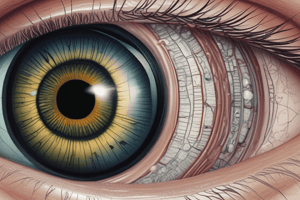Podcast
Questions and Answers
What is the primary function of the bony orbit?
What is the primary function of the bony orbit?
Where is the widest part of the orbit located?
Where is the widest part of the orbit located?
What is contained within the bony orbit?
What is contained within the bony orbit?
What is the shape of the bony orbit?
What is the shape of the bony orbit?
Signup and view all the answers
What is the function of the orbital cavity?
What is the function of the orbital cavity?
Signup and view all the answers
What is the shape of the seven bones from which the orbit is constructed?
What is the shape of the seven bones from which the orbit is constructed?
Signup and view all the answers
What lies posterior to the orbital septum and anterior to the levator aponeurosis?
What lies posterior to the orbital septum and anterior to the levator aponeurosis?
Signup and view all the answers
Which artery transmits blood and nerve through the supraorbital notch/foramen?
Which artery transmits blood and nerve through the supraorbital notch/foramen?
Signup and view all the answers
Which cranial nerve transmits visual information from the retina to the brain?
Which cranial nerve transmits visual information from the retina to the brain?
Signup and view all the answers
What is the main function of lacrimal glands?
What is the main function of lacrimal glands?
Signup and view all the answers
Which muscle in the orbit is responsible for controlling the movements of the eyeball and upper eyelid?
Which muscle in the orbit is responsible for controlling the movements of the eyeball and upper eyelid?
Signup and view all the answers
Which structure is formed by the frontal bone and is easily palpable, sharp in its lateral two-thirds, and more rounded medially?
Which structure is formed by the frontal bone and is easily palpable, sharp in its lateral two-thirds, and more rounded medially?
Signup and view all the answers
What is the main role of plain orbital muscles in the orbit?
What is the main role of plain orbital muscles in the orbit?
Signup and view all the answers
Which pair of cranial nerve provides sensory innervation to the eyeball, including the cornea?
Which pair of cranial nerve provides sensory innervation to the eyeball, including the cornea?
Signup and view all the answers
What is the most common quadrilateral with round corners that forms the orbital margin?
What is the most common quadrilateral with round corners that forms the orbital margin?
Signup and view all the answers
Study Notes
Bony Orbit Overview
- The primary function of the bony orbit is to protect the eyeball and support associated structures.
- The widest part of the orbit is located at the zygomatic bone region.
- The bony orbit contains the eyeball, muscles of the eye, nerves, blood vessels, and fat.
- The bony orbit has a shape resembling a quadrilateral with rounded corners.
Orbital Cavity Functions
- The orbital cavity serves to house and protect the eyeball and its associated components.
- Seven bones, including the frontal, zygomatic, maxillary, and sphenoid, form the structure of the orbit, giving it a complex shape.
Anatomical Features and Nerve Function
- Structures posterior to the orbital septum and anterior to the levator aponeurosis are part of the orbital fat and connective tissue.
- The supraorbital artery transmits blood and nerves through the supraorbital notch/foramen.
- Cranial nerve II (optic nerve) transmits visual information from the retina to the brain.
Glandular and Muscular Functions
- The main function of lacrimal glands is to produce tears that keep the surface of the eye moist and free from debris.
- The extraocular muscles are responsible for controlling the movements of the eyeball and upper eyelid.
Specific Anatomical Structures
- The structure formed by the frontal bone that is easily palpable and sharp on the lateral two-thirds while more rounded medially is the orbital rim.
- The plain orbital muscles primarily function to enable various eye movements and maintain proper positioning of the eye.
- Cranial nerve V1 (ophthalmic branch of the trigeminal nerve) provides sensory innervation to the eyeball, including the cornea.
Orbital Margin Characteristics
- The most common quadrilateral with round corners forming the orbital margin is the shape that summarizes the orientation and construction of the orbit's boundary.
Studying That Suits You
Use AI to generate personalized quizzes and flashcards to suit your learning preferences.
Description
Test your knowledge of ocular anatomy and physiology with this quiz on the orbit's bony structure and function. Explore the boundaries, contents, and characteristics of the orbital cavity in the context of optometry studies.




